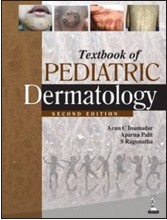Translate this page into:
Text book of Pediatric Dermatology
Correspondence Address:
Vibhu Mendiratta
Department of Dermatology, Venereology and Leprosy, Lady Hardinge Medical College and Assoc. Sucheta Kriplani and Kalawati Saran Children's Hospital, New Delhi - 110 001
India
| How to cite this article: Mendiratta V. Text book of Pediatric Dermatology. Indian J Dermatol Venereol Leprol 2014;80:280 |
 Editors: Arun C. Inamadar, Aparna Palit, S. Raghunatha
Editors: Arun C. Inamadar, Aparna Palit, S. Raghunatha
Publisher: Jaypee Brother Medical Publishers (P) Ltd, India.
Hardcover
ISBN 978-93-5152-083-2
Edition: Second, 2014
Pages: 717
INR 3995
The last decade has witnessed a growing awareness in dermatologists and pediatricians about the burden and spectrum of pediatric skin diseases in India. The sheer plethora of diverse dermatological diseases from infancy to adolescence coupled with the need to maintain a delicate balance between safety and efficacy of available modalities of treatment especially in pediatric skin diseases have earned pediatric dermatology its legitimate place in postgraduate training and clinical practice.
Despite the availability of a handful of handbooks/colored atlas on the subject, there has been a palpable need for a concise authentic volume on Pediatric Dermatology with an Indian flavor. The 2 nd edition of the Textbook of Pediatric Dermatology is a combined effort of three renowned and experienced editors along with a bevy of equally experienced authors who share a common interest in the subspecialty. The book has 38 chapters detailing a wide range of topics from must know areas which include both common problems and rare conditions. The focus is on important, core issues which include neonatal dermatology, genodermatoses, infections, eczemas, nutritional diseases, pigmentary problems, sexually transmitted diseases and cutaneous manifestations of systemic diseases. Readers get a clear Indian perspective of diseases. The book incorporates necessary details of various dermatoses comprehensively with the help of tables, flow charts and line diagrams, simplifying understanding and reproducibility. The contents are evidence based. Each chapter has an adequate number of recent references on the subject.
Of particular interest are the two new chapters (dermatosurgery and dermoscopy) in the 2 nd edition which provide encapsulated information on the subject and familiarize readers with the diagnostic application of dermoscopy and scope of surgical procedures in the management of pediatric dermatoses. Important disorders of nail and hair have also been covered. Some topics like genodermatoses, infections, papulosquamous conditions, vesiculobullous diseases and eczemas deserve a special compliment. The simple style of presentation does not in any manner compromise with the quantum of content. I am sure that readers would be easily able to grasp the fundamental concepts in pediatric dermatology. A vast gallery of colored clinical pictures of common and rare disorders in Indian children constitutes the most attractive component of the book. The richness of clinical photographs is the high point of the book and deserves a special mention. The editors should include additional tables on therapeutic ladder, pharmacological doses, laser therapy, biological agents and poisoning in children in the next addition which will make the rich content even more robust, informative, and instructional from the perspective of a text book.
The book would be a useful possession and easy reference text for pediatric dermatological diseases from an Indian perspective It fills the void for a simplified, comprehensive, easy to comprehend text book on pediatric dermatology for practitioners and trainee residents in dermatology and pediatrics.
Fulltext Views
5,237
PDF downloads
3,360





